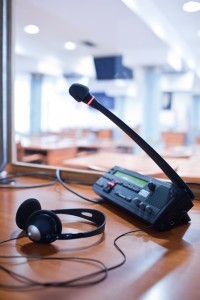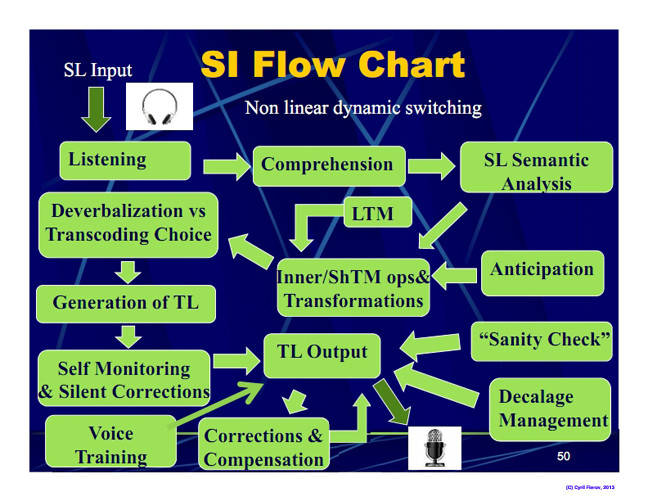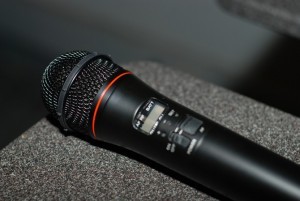Why add another simultaneous interpretation FAQ online? Because this one is written by an actual simultaneous interpreter!
Tell me a funny story about simultaneous interpreters?
Keep your cool is the lesson for budding simultaneous interpreters. There was an interpreter once who was in the middle of a pretty difficult passage. The microphone was on and everyone listened to her intently. She turned around and saw a little gray mouse in her booth. Like some people are, she is terribly afraid of mice! Imagine the challenge: you cannot scream, the mic is “hot”. You have to continue listening and speaking. She climbed onto her chair and this is how she finished her shift. And yes, this is a real story, we are just not sure if the mouse enjoyed the interpretation!
What is simultaneous interpretation?
Short answer: a very challenging but extremely interesting cognitive task. A long answer: Simultaneous interpretation is sometimes called “simultaneous translation” but this is incorrect. Translation is working with written text and interpreters work with oral speech.
 Imagine wearing a headset and repeating in your native language what you hear. This is the first step students who want to learn the skill take. Now imagine that you do it in a foreign language, add technical terminology (subdermatoglyphic, anyone? Or rotavator?) Add a fast speaker who does not use his own native language, add unfinished sentences and try to say all that in a different language without any mistakes and with correct pronunciation and grammar. Most importantly – do not lag behind the speaker by more than just a few words. Great workout for your brain.
Imagine wearing a headset and repeating in your native language what you hear. This is the first step students who want to learn the skill take. Now imagine that you do it in a foreign language, add technical terminology (subdermatoglyphic, anyone? Or rotavator?) Add a fast speaker who does not use his own native language, add unfinished sentences and try to say all that in a different language without any mistakes and with correct pronunciation and grammar. Most importantly – do not lag behind the speaker by more than just a few words. Great workout for your brain.
Why would anyone want to do it?
Because interpreters are adrenaline junkies: nothing beats interpreting a challenging speaker and seeing how your audience learns something they’d never be able to know without you. The overwhelming majority of conference interpreters deeply love what they do and it is not a 9 to 5 job: we constantly improve ourselves and you can wake up in the middle of the night thinking about how you would translate a particular word. We love a challenge and we love helping people communicate.
What types of simultaneous interpretation exist?
Strictly speaking only two: with or without simultaneous interpretation equipment.
Whispering interpretation. If you are not using equipment it is called chuchotage or “whispering interpretation.” The interpreter literally sits next to the client and says the interpretation into the client’s ear. “Whispering” is a misnomer, the interpreter must never actually whisper, because it is very damaging to your voice and vocal folds. He or she should speak softly but audibly. This mode of interpretation has serious constraints: although used, it is strongly discouraged by professional conference interpreters and should be employed only in very exceptional circumstances and for very short periods of time. The simultaneous interpreter gets tired much much quicker because of an additional cognitive load: you do not have any audio equipment for interpretation to be able to hear the speaker clearly and you cannot use your voice as comfortably as you would in the booth. Other delegates may distract the interpreter and the interpreter may distract them.
Interpretation with portable simultaneous interpretation equipment (sometimes called bidule in Europe). This is a tiny step up. The interpreters have a portable transmitter with a microphone and delegates have receivers with headsets. This mode of interpretation should be used for situations when you set up tours or, for example, factory visits i.e. when there is a need to move around. It should not replace regular simultaneous interpretation equipment.
Proper simultaneous interpretation booth. Now, that’s the way to do simultaneous interpretation! Interpreters are located in a soundproof booth. The booth can be either permanent (built in) or portable/mobile. Read below about what kind of equipment you will need for your conference.
How simultaneous interpretation developed?
Simultaneous interpretation was probably always there as chuchotage, but simultaneous interpretation with equipment is a child of the XXth century. French and later English replaced Latin as the language of diplomacy and by the 1920s it became clear that consecutive interpretation simply will not do for conferences with several languages and long presentations.
Interestingly, equipment for simultaneous interpretation was designed independently at about the same time by Edward Filene in the West and Dr. V.Z. Epshtein in the USSR. At first no one believed spontaneous simultaneous interpretation is possible, so it was used to read already translated texts. The earliest mention of the concept of simultaneous interpretation was made on 2 April 1925 in a letter from the American businessman and inventor Edward Filene to Sir E. Drummond. In 1927 a simultaneous interpretation system (by IBM) was first used at the League of Nations in the International Labor Conference.
 No one knew at that time what the best way to do simultaneous interpretation was. One proposal involved 3 interpreters: one would listen to a sentence and then would press a button that would activate a buzzer for the second interpreter. The second interpreter would start listening to the second phrase of the speaker and the first interpreter would translate the first phase of the speaker consecutively. Then the first interpreter would press a buzzer that would allow the second interpreter to start the translation. Oh, and by that time, the second interpreter has already pressed his buzzer that allowed the third interpreter to start listening to the third sentence of the speaker. As you can imagine, the madness never worked.
No one knew at that time what the best way to do simultaneous interpretation was. One proposal involved 3 interpreters: one would listen to a sentence and then would press a button that would activate a buzzer for the second interpreter. The second interpreter would start listening to the second phrase of the speaker and the first interpreter would translate the first phase of the speaker consecutively. Then the first interpreter would press a buzzer that would allow the second interpreter to start the translation. Oh, and by that time, the second interpreter has already pressed his buzzer that allowed the third interpreter to start listening to the third sentence of the speaker. As you can imagine, the madness never worked.
A major milestone for the development of simultaneous interpretation is the Nuremburg Trials.
After WWII simultaneous interpretation is used more and more often especially in international organizations.
How many simultaneous interpreters are there in the world?
It is impossible to say for sure, but if we take the strictest criteria, the International Association of Conference Interpreters – a top level international simultaneous interpreter organization – has over 3,000 members and has been there for over 60 years. They are all highly experienced professionals with years of experience and impeccable work ethics.
How simultaneous interpretation is done?
Interpreters train to perform several processes or procedures in parallel or in very quick succession: analyze what the speaker says, extract the message, prioritize information keeping in mind that we have only very limited time before we have to say our interpretation (usually a few seconds, this lag between the speaker and the interpreter is called decalage or ear voice span, EVS ). You also need to remember about manner, voice, correct terminology etc. You need to take into consideration your audience and make sure you are understood. Below is a diagram for more technically inclined that shows what stages and processes simultaneous interpretation may entail:

Simultaneous Interpretation Schematic
ShTM = Short Term Memory
LTM = Long Term memory
SL = Source language
TL = Target Language
As you can see there are very many things you need to keep in mind and students need extensive training and many years to become good conference simultaneous interpreters.
Where simultaneous interpreters work?
 Everywhere from the United Nations General Assembly hall to … bushes. Yes, this is an actual picture, the booth is not photoshopped in.
Everywhere from the United Nations General Assembly hall to … bushes. Yes, this is an actual picture, the booth is not photoshopped in.
What kind of education simultaneous interpreters have?
It is usually best to have formal post graduate education in conference interpretation. It may be as hard to learn the skill yourself even if you are bilingual, as it may be hard to master open heart surgery. You need to internalize a certain very peculiar set of skills and you cannot do it from books: you need constant feedback from an experienced trainer who is a practicing simultaneous interpreter. You simply cannot teach yourself simultaneous interpretation, though some may claim it is possible! Of course, early interpreters learned by trial and error, but we are very far ahead now in training pedagogy.
Are simultaneous interpreters freelancers or full time interpreters?
There are both full time and freelance simultaneous interpreters. Most interpreters are freelancers but there are full time interpreters in major international organizations (e.g. the UN family of organizations). If you engage a translation agency to provide professional simultaneous interpretation services, it is very likely that all the interpreters who will work at your conference will be freelancers hired by the agency.
What lifestyle conference interpreters have ?

Professional language interpreters are road warriors – they travel quite a bit.
Of course, marketing and regular business activities are important, but you constantly challenge yourself to study new topics and terminology especially if you never worked in these subject areas before. It is necessary not to be taken aback by an unknown commonly used term and to be at least superficially familiar with that topic. A good way to do it is to use dictionaries that list words by topic based on frequency.
My standard recommendation to students: start with the Random House Word Menu. After you are done with it, you may not know what “instability strip” is in astronomy but you will certainly not be thrown off your horse by a “globular cluster” or “the Doppler shift”. That is the difference between knowing the topic as a technical expert and a professional language interpreter. So you have professional dictionary readers here, and remember that interpreters have to do it all our working languages. An interpreter’s passive vocabulary may exceed 180 000 words!
Simultaneous interpreters are also road warriors: airports, taxis, and hotels are our lifestyle. After some initial period in your career the benefits of the quality you deliver begin to outweigh the cost of domestic and international travel.
Some discerning clients look at it as an asset not an expense: they simply cannot afford to hire people who may not be able to deliver especially if the mission is critical.
Why I need 2 (or even 3) simultaneous interpreters per language?
Cognitive load during simultaneous interpretation is immense. Average American speakers talk at 150-180 words per minute. Let’s assume 170 WPM. If your conference lasts for 6 hours a day (of pure talking) it is 61,200 words or over 244 standard pages of text. Imagine reading a book of 244 pages in one day and retell it in a different language. After some time your brain starts to play a very interesting trick on you: you think that you are interpreting correctly but in reality you are saying gibberish. That must never happen in professional interpretation. In our experience quality begins to deteriorate after 30 minutes of talking but it depends heavily on the rate of delivery and the difficulty of the text. That is why interpreters must work in pairs for every language and change every 30 minutes, but for extremely difficult speeches they can alternate every 15 minutes. In some cases 3 interpreters are engaged for every language.
What equipment is used in simultaneous interpretation?

Handheld Microphone
Portable transmitters and receivers or a soundproof booth, headsets, microphones both for the interpreter and the speakers, special tabletop consoles for interpreters, amplifiers, etc. If you set up a conference and have no experience with simultaneous interpretation equipment, it is best to let your simultaneous interpretation equipment provider handle that: there are very specific requirement to this kind of equipment and several ISO standards exist to make sure that the equipment is of the highest quality. Your provider should specialize in conference interpretation equipment: a simple video or audio production company may be great at audio and video but not have enough expertise in interpreting equipment. You must also have an onsite technician to handle the equipment and this is a part of the service a professional translation agency would provide.
Is it expensive to hire simultaneous interpreters?
Yes and this is how it has to be. It is a very specialized skill and you get what you pay for. Costs of hiring interpreters, equipment, audio technicians, travel, project management may add up, but think of it as an investment and not a liability: if your conference interpretation is substandard and delegates do not understand each other, why have the conference in the first place?
You should ask for estimates from several simultaneous interpretation agencies, compare them and collect interpreter resumes as well. The agency client portfolio and references are also important, but pay attention to the interpreters’ experience level.
What are advantages and disadvantages of simultaneous interpretation?
Disadvantages: requires specialized equipment, more expensive, limited to the conference room.
Advantages: definitely saves time, multiple languages may be supported at the same time (a conference with 24 languages in the same room is the biggest one we know of), simultaneous interpretation may also be a little bit more accurate and better in reproducing the structure of the original speech: while professional consecutive interpretation can be done very accurately too, the very nature of consecutive implies that the interpreter relies on his memory and his notes more and reproduces more of a gist of the speech.
Who are consultant interpreters?
Consultant interpreters are experienced interpreters who assemble teams of interpreters on a project by project basis for a particular client. They are savvy in project management and their difference from translation or interpretation agencies is that they are interpreters themselves and not simply project managers. They may act as individuals or have an agency.
Do simultaneous interpreters specialize in particular topics?
 Yes and no. Some full time simultaneous interpreters may work only for NASA or for an oil company, for example, and do only that. However, freelance interpreters work on a broad variety of different projects and learn by osmosis.
Yes and no. Some full time simultaneous interpreters may work only for NASA or for an oil company, for example, and do only that. However, freelance interpreters work on a broad variety of different projects and learn by osmosis.
Of course, they will never know a topic as well as a technical expert would, but with an experienced simultaneous interpreter it is not usually an issue, because they are exposed to a variety of different topics that often overlap and interpreters DO prepare for their assignments. Sometimes it may take a week to prepare for a one day conference and the cost of preparation is usually included into our daily rate.
How interpreters survive the stress of simultaneous interpretation?
It is all about honing the skill constantly and practicing all the time. During simultaneous interpretation you enter a meditative flow that to a great degree reduces your cognitive overload. Just like an experienced climber uses every little bump or crevice on the seemingly smooth wall he is climbing , a good simultaneous interpreter does everything to convey the message with all its nuances and in the most efficient way. It is a combination of technical skill and language art. Interpreters’ job is so intense that it is compared to air traffic controllers’ as far as the level of stress is concerned!
How can I help my interpreters to perform better?
Discuss your expectations and requirements with your interpretation services provider. What do you want to achieve during your conference or event? You must brief interpreters in advance and provide as much information as you can including PowerPoint presentations and speaker bios. The more they know the better the quality will be.
During your presentation do not be too fast, but speak at the rate of delivery that is comfortable to you personally. Do not try to “help” the interpreters by making pauses, it will actually make their job more difficult.
Concentrate on your message and establishing rapport with the audience: it is the interpreters’ job to present you in the best way they can in their languages.
Avoid excessive jargon, though technical terminology in your area of expertise is perfectly OK, avoid untranslatable jokes or things that only people in your culture will really understand or appreciate e.g. references to American football, cricket, etc. It should not, however, stop you from using humor and being yourself!
 Learn to use your microphone correctly: do not blow into it, do not speak into it directly, tap it or drop it! Remember to turn it off when you are done speaking if you are asked to. The reason is that it is difficult for interpreters to hear if more than one microphone is on.
Learn to use your microphone correctly: do not blow into it, do not speak into it directly, tap it or drop it! Remember to turn it off when you are done speaking if you are asked to. The reason is that it is difficult for interpreters to hear if more than one microphone is on.
What value simultaneous interpretation can bring to your business?
Using simultaneous interpretation as an asset, it not a chore or liability. It is one of the best ways to convey your message to your foreign language speaking audience. If you prepared correctly, hired a reputable simultaneous interpretation agency and provided preparation materials, everything should run very smoothly at least as far as communication between the parties is concerned. Remember that good simultaneous interpreters are not noticed – as if they are not here – only bad ones are!
Cyril Flerov
Member of AIIC, Russian A, English B
Simultaneous interpretation trainer
Read about how you as a client can evaluate quality of simultaneous interpretation.
InterStar Translations is a conference interpretation agency providing simultaneous and consecutive interpretation services between English and a variety of other languages, including Russian, Spanish, French, Chinese, Japanese etc.

